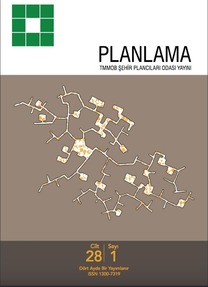Kentsel Mekanın Sosyallik Durumları Üzerine Biçim Odaklı Bir Bakış
A Form-Based Perspective Towards Urban Sociality
___
- Anderson, E (2017). The cosmopolitan canopy: Race and civility in everyday life. New York: W. W. Norton & Company.
- Elden, S (2004) Understanding Henri Lefebvre: Theory and The Possible, Continiuum, London.
- Enderson, T (2010). Introduction: Thinking About Rhythm and Space, Ge- ographies of Rhythm: Nature, Place, Mobilities and Bodies, Ashgate, London, 5-30.
- Gandy, M (2014). The fabric of space: Water, modernity, and the urban imagi- nation. Cambridge: MIT.
- Goffman, E (1959) The Presentation of Self in Everyday Life. Doubleday, New York.
- Graham, S, & McFarlane, C. (2015). Infrastructural lives: Urban infrastruc- ture in context. London: Routledge.
- Kahya GY (2020a). Eylem Kanalı Olarak Kent Biçimi. Yapı (Mayıs-Haziran): 50-56.
- Kahya GY (2020b). Sanat Girişimlerinin İstanbul’un Yaratıcı Alanının Gelişiminde Oynadığı Roller, 7. Kentsel ve Bölgesel Araştırmalar Ağı Sempozyumu Bildiri Kitabı, 10-12 Eylül 2020: 535-550, Mersin.
- Kaika, M (2004). Interrogating the geographies of the familiar: Domesticat- ing nature and constructing the autonomy of the modern home. Klinenberg, E (2018). Palaces for the people: How social infrastructure can help fight inequality, polarization, and the decline of civic life. London: Penguin.
- Kültürel Aracılar Proje Raporu (2019). Der. Ece Sarıyüz. Salt Araştırma ve Programlar.
- Latham A and Layton, J (2019). Social Infrastructure and The Public Life of Cities: Studying urban sociality and public spaces. Geography Compass 13(7): 5-15.
- Lefebvre, H (1991). The Production of Space. Nicholson-Smith (çev.). New York: Wiley-Blackwell. (İlk baskı 1974).
- Lefebvre, H (2004). Elements of Rhythmanalysis: An Introduction to the Un- derstanding of Rhythms. S. Elden & G. Moore (çev.). Rhythmanalysis: Space, Time and Everyday Life içinde (s. 5-72), London: Continuum. (İlk baskı 1992).
- Leighton, A (2007). On Form. Oxford University Press.
- Levine, C (2017). Biçimler: Bütün, Ritim, Hiyerarşi, Ağ (çeviren: Didem Din- çsoy). İstanbul: Koç Üniversitesi Yayınları.
- Moussavi, F (2011). Giriş. S. Lopez, G. Ambrose, B. Fortunato, R. Ludwing & A. Schricker (Ed.), Biçimin İşlevi içinde (s. 7-37). P. Derviş (çev.). İstanbul: Yem Yayınevi. (İlk baskı 2009).
- Oldenberg, R (1989). The great good place: Cafes, coffee shops, bookstores, bars, hair salons, and other hangouts at the heart of a community. Boston: Da Capo Press.
- Simmel, G (1950). The Sociology of Sociability, trans Kurt H. Wolf, Free Press, London.
- ISSN: 1300-7319
- Yayın Aralığı: Yılda 3 Sayı
- Başlangıç: 1986
- Yayıncı: TMMOB Şehir Plancıları Odası
Kentsel Güvenliğin Sağlanmasında Tasarım Rehberleri
Nilgün Çolpan Erkan, Tuba Koca
Yok Olan Spor Yapılarının Ardından Kentte Yıkma Eylemi ve Bellek: Trabzon Örneği
Şengül Yalçınkaya, Ümran Sofuoğlu
Kentsel Mekanın Sosyallik Durumları Üzerine Biçim Odaklı Bir Bakış
Kadıköy Örneğinde Alternatif Tiyatro Sahnelerinin Kamusallık Bağlamında Kamusal Mekân ile Etkileşimi
Ebru Firidin Özgür, Devran Bengü
Julia Kristeva’da Platonik Mekân Kavramı “Chora”
1999 Depremlerinin Ardından Planlama Mevzuatı Üzerine Bir Değerlendirme
The Effect of Changes in Coastal Law on Land Use Change in Coastal Settlements: Kuşadası Center Case
Neriman Yörür, Ayşegül Altınörs Çırak, Sibel Ecemiş Kılıç, Rana Başak Serim, Neslihan Karataş
Neslihan Karataş, Mehmet Ali Kaya
Direnişçi Planlama: Gelişmekte Olan Ülkeler İçin Yeni Bir Planlama Kuramı
